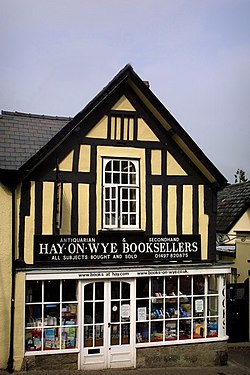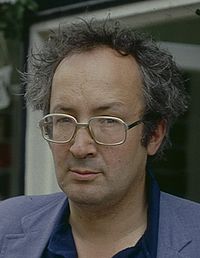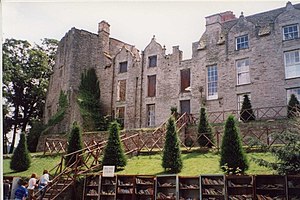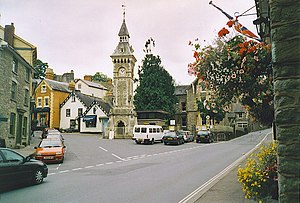Hay-on-Wye
| Hay-on-Wye Welsh: Y Gelli Gandryll or Y Gelli | |
| Brecknockshire | |
|---|---|
 A second-hand bookshop at Hay-on-Wye | |
| Location | |
| Grid reference: | SO225425 |
| Location: | 52°4’48"N, 3°7’48"W |
| Data | |
| Population: | 1,846 |
| Post town: | Hereford |
| Postcode: | HR3 |
| Dialling code: | 01497 |
| Local Government | |
| Council: | Powys |
| Parliamentary constituency: |
Brecon & Radnorshire |
Hay-on-Wye, known also as Hay, is a small market town on the eastern edge of Brecknockshire. It often described as "the town of books" because of the vast number of second-hand bookshops found there.
The town lies within the Brecon Beacons National Park, just north of the Black Mountains. It stands on the River Wye, which forms the border with Radnorshire and on the western bank of the Dulas Brook, which forms the border with Herefordshire and joins the Wye just north of the town here. The village of Cusop, which lies on the other side of the Dulas Brook in Herefordshire, forms part of the town area.
Hay has approximately 1,900 inhabitants. The nearest city is Hereford, the county town of Herefordshire, some 22 miles to the east.
Contents
Book town
Hay-on-Wye has with over thirty bookshops, many selling specialist and second-hand books,[1] which has made the town a destination for bibliophiles.
Hay's status as the "Book Town" began with Richard George William Pitt Booth. Booth opened a second-hand bookshop in the town, and later encouraged his friends in the trade to come to Hay also, until this little town became famous for its bookshops and has become a busy tourist destination based on that.
Bookshop maps are available from the tourist information centre. The biggest bookshop remains Richard Booth's, its main outlet being in Hay Castle.
"King of Hay-on-Wye"
On 1 April 1977, Richard Booth conceived a publicity stunt. Seeing Hay's position uncertainly between England and Wales, he declared Hay-on-Wye to be an 'independent kingdom' with himself as its monarch.[2]. He recently announced plans to sell his bookshop and move to Germany; on this occasion local Member of Parliament, Roger Williams was quoted as saying "His legacy will be that Hay changed from a small market town into a mecca for second-hand book lovers and this transformed the local economy"[3].
Guardian Hay Festival
Since 1988, Hay-on-Wye has been the venue for a literary festival, now sponsored by The Guardian newspaper, which draws a claimed 80,000 visitors over ten days at the beginning of June to see and hear big literary names from all over the world.
Castle
Hay-on-Wye, like Builth Wells, has two Norman castles within a short distance of each other. It seems likely that Hay was fortified by William Fitz Osbern during his penetration of south-east Wales in the summer of 1070, when he defeated three Welsh kings. The history of the site then continues through the lordships of the de Neufmarchés, which was confirmed at the Battle of Brecon in 1093, and also the Gloucester/Hereford families until 1165, when the district of Brycheiniog passed into the hands of the William de Braose|de Braose dynasty of Marcher Lords. In 1230 Hay Castle passed to the de Bohuns and the local history, including the battle near Hay in 1231, is continued through the Mortimer Wars of the 1260s and the battle near Brecon in 1266 down to the death of Earl Humphrey de Bohun, 3rd Earl of Hereford in 1298.
The first castle
Lying close to St Mary’s Church on the western edge of Hay-on-Wye is a small but well-preserved castle motte. The site overlooks a gorge and small stream leading to the River Wye, which was undoubtedly one reason for the construction of a motte and bailey castle here. A recently levelled platform under the car park to the north east may have once have housed the castle's bailey. This little fortress was probably the work of William Revel, a knight of Bernard de Neufmarché, and may later have been the seat for the manor or commote of Melinog. Other than this the motte has no further recorded history.
The stone castle
The main fortress within Hay-on-Wye was situated on the great site commanding the town and river under the current ruins of the castle and mansion. This was undoubtedly the 'castello de haia' handed to Miles de Gloucester, 1st Earl of Hereford in 1121 with the daughter of Bernard de Neufmarché. It is most likely that the keep stood by this time. It is therefore possible that this is the oldest Norman tower in Wales, dating to the onslaught of William Fitz Osbern in 1070. During the anarchy (1136-54) in the reign of King Stephen, a series of charters were issued by the Gloucesters concerning the castle. In 1165 the last of Miles de Gloucester's male descendants was killed at nearby Bronllys Castle and Hay-on-Wye Castle passed into the hands of William de Braose, 3rd Lord of Bramber and of New Radnor and Buellt.
The de Braose dynasty were energetic lords and probably built the core of the gatehouse which now stands besides the keep. In the summer of 1198 a major English army formed here before marching off to victory at the Battle of Painscastle some four miles to the north.
In 1230 the last de Braose of Brecon, William, was hanged by Prince Llywelyn ab Iorwerth and Brecon lordship with Hay-on-Wye passed into the hands of the de Bohuns. Taking advantage of this in 1231, Prince Llywelyn ravaged the lands of his de Bohun in-laws during which Hay-on-Wye town was burnt, although the castle survived the onslaught. The castle saw service in the Barons' War of 1263 to 1266, changing hands three times, once being surrendered to the great Simon de Montfort, 6th Earl of Leicester. With the conquest of Wales by King Edward I, life became more peaceful in the town.
Around 1401 both town and castle suffered damage by the forces of Owain Glyndwr, although the castle was listed as defensible against the Welsh in 1403. The fortress later passed to the Earls of Stafford, who were to become the unlucky Dukes of Buckingham during the Wars of the Roses. The castle was repaired during the conflicts of the 1460s, although its military use would have been somewhat dubious against cannon.
In the 1660s, James Boyle of Hereford built a new mansion on the north side of the castle, while most of the curtain wall was demolished to improve the views. The mansion is now used for second-hand bookselling.
Remains of castle
The keep is roughly thirty feet square and was once of four storeys. The corners of the tower have been much rebuilt, probably due to insecure foundations. The entire south east corner of the tower has been replaced and it is possible that when first constructed there was a spiral stair here to allow access to the upper floors. This tower is similar to the keep found at Goodrich Castle.
At some time in the 12th century the powerful curtain wall or "shell keep" with gate was added to the rampart around the site. This gateway is one of the finest carved castle gateways in Wales and is comparable with the much more ornate work at Newcastle near Bridgend. The two gates hanging within the gateway, although of different ages, would appear to be very old — the gates at Chepstow Castle have been dated by dendrochronology to the reign of King Henry II (1154-89).
Probably during the troubles of the Barons' War a small gatehouse was added in front of the gateway to make a proper gatehouse complete with portcullis. The portcullis mechanism mounted on the wall walk was reached via a flight of steps up over the back of the gate passageway which also allowed access to the wall walks.
References
- ↑ Hay-on-Wye booksellers. Retrieved on 2008-05-04.
- ↑ "Richard Booth". bbc.co.uk. http://www.bbc.co.uk/wales/mid/halloffame/arts/richard_booth.shtml. Retrieved 2007-05-11.
- ↑ "Self-styled king of Hay sells up". bbc.co.uk. 2005-08-18. http://news.bbc.co.uk/1/hi/wales/mid/4159106.stm. Retrieved 2007-05-11.
- Remfry, P.M., Hay on Wye Castle, 1066 to 1298 (ISBN 1-899376-07-0)


